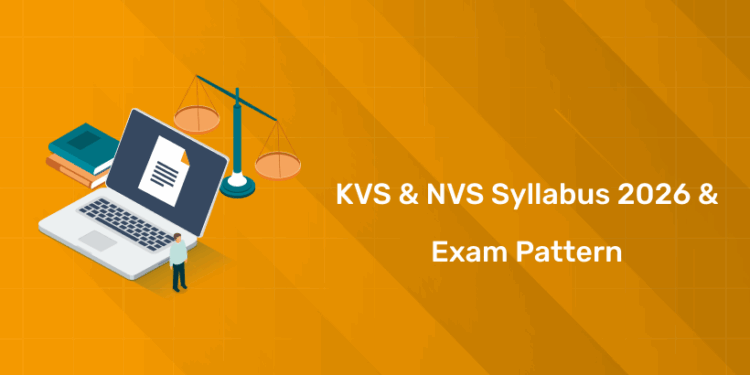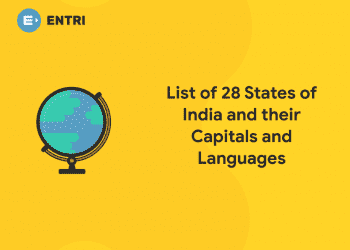Table of Contents
The KVS & NVS Syllabus 2026 & Exam Pattern is essential for candidates preparing for PGT, TGT, PRT, Principal, Assistant Commissioner, Librarian, JSA, SSA, Stenographer and MTS posts. This updated CBSE-based syllabus covers Tier-1 and Tier-2 exam patterns, including Reasoning, Numeric Ability, Computer Literacy, GK, English, MIL and subject-wise topics. Check the complete syllabus to improve your KVS NVS exam preparation.
KVS & NVS Syllabus 2026 PDF & Exam Pattern – Download Post-Wise PDFs
Get the official KVS & NVS Syllabus 2026 and Exam Pattern PDF for all posts in one place. These CBSE-approved PDFs include the complete Tier-1 & Tier-2 syllabus, subject-wise topics, marking scheme, negative marking, and post-wise exam structure for PGT, TGT, PRT, Principal, Vice Principal, AE, AO, JSA, SSA, Stenographer, MTS and more.
DAILY CURRENT AFFAIRS – FREE PDF
Download the latest updated syllabus & exam pattern PDF
| Post Name | Download Link |
|---|---|
| PGT (All Subjects) | |
| TGT (All Subjects) | |
| PRT | |
| Principal | |
| Vice Principal | |
| Assistant Commissioner | |
| Administrative Officer | |
| Finance Officer | |
| Assistant Section Officer (ASO) | |
| Junior Secretariat Assistant (JSA) | |
| Senior Secretariat Assistant (SSA) | |
| Stenographer Grade I & II | |
| Lab Attendant | |
| Junior Translator | |
| AE (Civil) | |
| MTS (NVS) |
KVS & NVS Exam 2026 – Overview
1: The first recipient of the ‘Rajiv Gandhi Khel Ratna’ award?
| Feature | Details |
|---|---|
| Recruiting Bodies | Kendriya Vidyalaya Sangathan (KVS), Navodaya Vidyalaya Samiti (NVS), CBSE |
| Posts Covered | PGT, TGT, PRT, Principal, Vice Principal, Assistant Commissioner, AO, FO, AE, Librarian, JSA, SSA, Stenographer, Lab Attendant, MTS |
| Selection Stages | Tier-1 (Prelims), Tier-2 (Subject Exam), Interview/Skill Test (as applicable) |
| Tier-1 Mode | OMR-Based Objective Test |
| Tier-2 Mode | Subject Knowledge Test (Objective + Descriptive) |
| Interview Weightage | 15% (for applicable posts) |
| Tier-2 Weightage | 85% (for interview posts) |
| Skill Test | For JSA, Stenographer Grade I & II |
| Negative Marking | Tier-1: 1 mark; Tier-2: 0.25 mark per wrong answer |
| Tier-1 Duration | 2 Hours (No sectional timing) |
| Tier-2 Duration | 2.5 Hours |
| Languages (Tier-1) | English + 12 Modern Indian Languages |
| Application Mode | Online through CBSE/KVS/NVS official portals |
| Eligibility | Indian Nationals only |
| Fee Exemption | SC, ST, PwBD, Ex-Servicemen (Processing fee applicable) |
| Salary Range | ₹18,000 – ₹2,09,200 (Post-wise) |
| Document Verification | Mandatory at final stage |
| Official Websites | cbse.gov.in, kvsangathan.nic.in, navodaya.gov.in |
Enroll in Kerala's Top-rated HSA Coaching Program!
സർക്കാർ ജോലി എന്ന സ്വപ്നം ഇനി സ്വപ്നം മാത്രമല്ല! Join Entri's HSA Coaching Program
Join Now!KVS NVS Study Notes 2026 PDF Download
| Topics | Link |
| English Grammar | |
| English Vocabulary | |
| English Sentance Identification | |
| Computer Literacy | |
| Environmental Science | |
| Hindi Basha | |
| Numerical Ability | |
| Basic Maths | |
| Type of Setences (English) | |
| Vachan (Hindi) | |
| Linkers | |
| DNA | |
| Double Circulation (Biology | |
| GST | |
| Internal Trade | |
| Kasthurirangan Report | |
| Cardinal Utility | |
| Summer of Beautiful White Horse (English) | |
| Potrait of Lady (English) | |
| Constitution framing | |
| Mahajanapadas | |
| Correlatives | |
| Iswaran The Story Teller | |
| The lake Isle Innisfree | |
| Factors of production | |
| Social Science | |
| Russian Revolution | |
| Acts on Indian Constitution | |
| Indian Constitutional Structure | |
| Public Administration | |
| 5th Year Plan | |
| E Governance | |
| Disaster Management | |
| Indian Geography | |
| World History | |
| Indian History | |
| Law & Order | |
| Indian Polity |
KVS & NVS Exam Pattern 2026 – Tier-1, Tier-2, Interview & Skill Test
The KVS & NVS Exam Pattern 2025 includes a Tier-1 Preliminary (Qualifying) Exam, a Tier-2 Subject Knowledge Exam, followed by an Interview or Skill Test depending on the post. The exam is conducted in OMR (Objective) mode, strictly bilingual, and based on post-specific difficulty levels. Understanding the complete exam pattern is essential for scoring high and clearing the recruitment exam.
KVS & NVS Tier-1 Exam Pattern 2026 (For All Posts Except NVS MTS)
- Mode: OMR, Objective
- Duration: 2 Hours
- Total Questions: 100
- Total Marks: 300
- Marking Scheme: +3 for correct, –1 for wrong
- Sections Are Not Time-Bound Individually
- Medium: English + one Modern Indian Language
| Part | Subject | Qs | Marks |
|---|---|---|---|
| I | General Reasoning | 20 | 60 |
| II | Numeric Ability | 20 | 60 |
| III | Basic Computer Literacy | 20 | 60 |
| IV | General Knowledge | 20 | 60 |
| V | English Language | 10 | 30 |
| VI | MIL (Hindi/Assamese/Bengali/Gujarati/Kannada/Malayalam/Marathi/Odia/Punjabi/Tamil/Telugu/Urdu) | 10 | 30 |
| Total | — | 100 | 300 |
NVS MTS Tier-1 Exam Pattern 2026
- Mode: OMR
- Duration: 2 Hours
- Total Questions: 100
- Total Marks: 300
| Part | Subject | Qs | Marks |
|---|---|---|---|
| I | General Awareness & Current Affairs | 20 | 60 |
| II | Basic Computer Operations | 40 | 120 |
| III | English Language | 20 | 60 |
| IV | MIL (12 Languages) | 20 | 60 |
| Total | — | 100 | 300 |
KVS & NVS Exam Pattern 2026 Tier-2 (Subject Knowledge Test)
- Mode: Pen-Paper + OMR
- Duration: 2.5 Hours
- Total Questions: 70
- Total Marks: 100
- Medium: Hindi & English (except PGT MIL & TGT 3rd Language – only concerned language)
- Marking: +1 correct, –0.25 wrong
| Component | Qs | Marks |
|---|---|---|
| Objective | 60 | 60 |
| Descriptive | 10 | 40 |
| Total | 70 | 100 |
Medium of KVS & NVS Examination 2026 – Tier-1 & Tier-2
- Parts I–IV (Qs 1–80): Bilingual (English + chosen MIL)
- English Section: English only
- MIL Section: In the chosen language only
- Language choice once submitted cannot be changed
Expected Knowledge Level (Tier-1)
- PGT / Principal / VP / AC: Post-Graduation Level
- TGT / AO / FO / AE / ASO / JT / Steno / SSA: Graduation Level
- PRT / JSA / Lab Attendant: Senior Secondary Level
- MTS: Secondary Level
Shortlisting in Tier-1
- Candidates shortlisted 1:10 ratio for Tier-2.
- Combined Tier-1 may be held for multiple posts; merit lists generated separately.
- Multiple responses = treated as wrong (–1).
- No re-evaluation allowed.
Shortlisting After Tier-2
- Interview: 1:3 ratio
- Skill Test (if applicable): 1:5 ratio
- Ties resolved as per recruitment rules
- No re-checking or re-evaluation permitted
Enroll in Kerala's Top-rated HSA Coaching Program!
സർക്കാർ ജോലി എന്ന സ്വപ്നം ഇനി സ്വപ്നം മാത്രമല്ല! Join Entri's HSA Coaching Program
Join Now!KVS & NVS Syllabus 2026 – Updated Syllabus for All Posts (Tier-1 & Tier-2)
The KVS & NVS Syllabus 2026 provides a clear structure for candidates preparing for various posts including PGT, TGT, PRT, Vice Principal, Principal, Assistant Commissioner, Administrative Officer, Finance Officer, Stenographer, JSA, SSA, Lab Attendant and NVS MTS.
The syllabus is divided into Tier-1 (Preliminary) and Tier-2 (Subject Knowledge Examination). Understanding the detailed syllabus is essential to secure a high score and qualify for Interview or Skill Test.
KVS & NVS Tier-1 Syllabus 2025 (Preliminary – Qualifying)
The Tier-1 syllabus covers General Reasoning, Numeric Ability, Basic Computer Literacy, General Knowledge, English Language, and Modern Indian Languages.
For NVS MTS, the syllabus includes General Awareness, Basic Computer Operations, English, and MIL.
Tier-1 Syllabus Includes:
- General Reasoning: Logical thinking, analytical reasoning, verbal & non-verbal reasoning
- Numeric Ability: Arithmetic, averages, ratio, percentage, profit & loss, time & work, basic calculations
- Basic Computer Literacy: Basic hardware/software, MS Office, internet usage, digital terminology
- General Knowledge: Current affairs, Indian history, polity, geography, economy, education sector updates
- English Language: Grammar, comprehension, vocabulary, error spotting
- Modern Indian Languages (12 MIL options): Hindi, Assamese, Bengali, Gujarati, Kannada, Malayalam, Marathi, Odia, Punjabi, Tamil, Telugu, Urdu
The difficulty level varies:
- PGT/Principal/AC/VP – Post Graduation level
- TGT/AO/FO/AE/ASO/Translator/Steno/SSA – Graduation level
- PRT/JSA/Lab Attendant – Senior Secondary level
- MTS (NVS) – Secondary level
KVS & NVS Tier-2 Syllabus 2026 (Subject Knowledge Exam)
Tier-2 is the core subject syllabus, containing both Objective and Descriptive questions. The detailed syllabus for each post/subject is provided on the official KVS & NVS recruitment websites.
Tier-2 Syllabus Includes:
- Subject Knowledge (Post-specific)
- Pedagogy (For teaching posts)
- Curriculum understanding
- Educational concepts & methodologies
- Application-based subject questions
- Descriptive writing (short/long answers)
Tier-2 tests deep knowledge of the subject chosen by the candidate and is the primary basis for shortlist for Interview (1:3) or Skill Test (1:5).
KVS & NVS Skill Test Syllabus 2026 (For Applicable Posts)
Posts like Stenographer Grade-I/II and Junior Secretariat Assistant include:
- Typing Test (English/Hindi, minimum required speed)
- Shorthand Test (for Steno posts)
- Computer Proficiency Test: MS Word, Excel, Access, PowerPoint, internet basics
- Minimum 40% marks required in CPT.
How to Download KVS & NVS Syllabus 2026 – Step-by-Step Guide
Downloading the KVS & NVS Syllabus 2026 is very easy if you follow the steps given below. These steps work for all posts including PGT, TGT, PRT, Principal, Assistant Commissioner, AE, AO, JSA, SSA, Stenographer, MTS, and more.
Step 1: Visit the Official Website
Go to any of the official websites where the syllabus is published:
- CBSE – cbse.gov.in
- KVS – kvsangathan.nic.in
- NVS – navodaya.gov.in
All three portals host the official recruitment syllabus.
Step 2: Open the ‘Recruitment’ Section
On the homepage, look for the “Recruitment” or “Announcements” tab.
Click on it to open the page containing all recruitment-related updates.
Step 3: Find the Notification Link
- Scroll through the list and look for: “KVS & NVS Recruitment 2025 – Detailed Notification / Syllabus”
- There will be a PDF issued by CBSE on behalf of KVS & NVS.
Step 4: Click on the Syllabus PDF
Under the notification, you will see:
- Syllabus PDF for Tier-1
- Syllabus PDF for Tier-2 (Subject Knowledge)
- Post-wise Syllabus
Click on the PDF you want to download.
Step 5: Download or Save the Syllabus
Once the PDF opens:
- Click Download / Save icon
- Choose location on your device
- Save the syllabus for offline use
Process of Allocation of Candidates to KVS & NVS 2026
The KVS NVS Recruitment 2026 introduces a merit-based Process of Allocation of Candidates. Understanding this procedure is essential for every applicant appearing for Tier-2, Interview, or Skill Test.
1. Mandatory Submission of Post Preference for KVS & NVS
After the final merit list preparation, candidates who appear in Tier-II and Interview/Skill Test and find their names in:
- Combined merit list (KVS + NVS) for the same post, or
- Separate merit lists for multiple posts,
must MANDATORILY submit their preferences for:
- Preferred post, and
- Preferred organisation (KVS or NVS)
This preference submission is done online through a dedicated portal available in the candidate’s login. The link remains active only for the officially notified period, and candidates must complete it within that time period.
2. Merit-Based Allocation of Posts in KVS and NVS 2026
The allocation of posts in KVS or NVS is carried out strictly based on:
- Candidate’s merit position (total score), and
- Preferences submitted during the preference-filling window.
Even if a candidate appears for multiple posts, only ONE final posting is allotted based on the highest position they secure according to:
- Overall merit, and
- Choice indicated in the preference link.
Important: Once a post is allotted, the candidate cannot request reassignment under any circumstances.
3. No Changes Allowed in Post or Organisation Preference
Once the preference for KVS/NVS is submitted:
- No changes, corrections, or modification requests will be accepted.
- Even genuine reasons, errors, or oversight will NOT lead to reconsideration.
4. Candidates Who Do Not Fill Preferences Will Not Be Considered
Candidates failing to submit preferences within the deadline will be:
- Excluded from the final merit allocation, and
- Will not be allotted any post in KVS or NVS.
Thus, preference filling is a mandatory and decisive step.
5. Allocation of Posting by KVS & NVS 2026
Once CBSE finalizes the post allocation:
- KVS and NVS will independently conduct posting allocation.
- Posting locations, school assignments, and regional positioning are handled solely by KVS/NVS, not CBSE.
Candidates must wait for the respective organizations to issue detailed posting letters.
6. No Waiting List in KVS NVS Recruitment
The recruitment procedure includes:
- NO waiting list,
- NO supplementary list, and
- NO additional round of allocation.
Only candidates who make it to the final list are considered for posting.
7. Final Decision-Making by CBSE
The CBSE, which conducts the exam, retains full authority over:
- Mode of selection,
- Criteria of shortlisting,
- Eligibility for Interview/Skill Test, and
- Any changes in recruitment methodology.
These decisions are final and binding—no correspondence or objections will be entertained from candidates.
KVS & NVS 2026 Exam Centre & Admit Card Information
Understanding exam logistics is crucial for all candidates.
Tier-1 & Tier-2 Exam Centres for AC, Principal & Vice-Principal
Candidates applying for:
- Assistant Commissioner (Academic)
- Assistant Commissioner
- Principal
- Vice-Principal
must note:
Tier-1 and Tier-2 exams for these posts are conducted ONLY in Delhi/NCR.
Exam Cities for Other KVS & NVS Posts
For all other positions, exam cities for Tier-I, Tier-II, and Skill Test depend on:
- Number of applicants
- Administrative feasibility
The examination body (CBSE) has the right to:
- Randomly allot cities
- Change locations due to administrative reasons
Exam centre changes cannot be requested by candidates.
Display of Exam City and Admit Cards
For Tier-1 Exam
- Exam city information → 15 days before exam
- Admit card with detailed centre info → 2 days before exam
For Tier-2 / Interview / Skill Test
- Exam city information → 15 days before scheduled test
- Admit card → 2 days before test
Download of e-Admit Cards & Shortlisting Status
Candidates can download:
- Tier-I Admit Card
- Tier-II Admit Card
- Interview/Skill Test Admit Card
- Shortlisting Status
ONLY through their application login.
- No email, SMS, or hard copy is provided.
- Candidates must self-check and stay updated.
Regular Monitoring of CBSE, KVS, and NVS Websites
Candidates must regularly monitor:
- CBSE official website
- KVS official website
- NVS official website
for updates related to:
- Exam dates
- City intimation
- Admit cards
- Notices
- Shortlisting statuses
Neither CBSE nor KVS/NVS responds to email queries about exam schedules.
Provisions for Differently Abled Candidates in KVS & NVS Recruitment 2026
The KVS & NVS Recruitment 2025 follows a transparent and inclusive policy for Persons with Benchmark Disabilities (PwBD) as defined under Section 2(r) of the RPwD Act 2016. These provisions ensure equal opportunity, fairness, and accessibility during the entire examination process.
1. Mandatory Disability Certificate for PwBD Category
Candidates applying under the PwBD category must submit:
- Certificate in PROFORMA-V-A / V-B / V-C, and
- UDID Card (Unique Disability ID)
These documents must be issued by an authorized government authority as per the RPwD Act 2016. This verification is mandatory to receive any relaxation or facility.
2. Facility of Scribe/Reader/Lab Assistant for PwBD Candidates
Candidates with benchmark disabilities having limitations in writing or speed may opt for:
- Scribe
- Reader
- Lab Assistant
3. Automatic Scribe Facility for Certain Disability Categories
The following disability groups automatically qualify for a scribe (upon request):
- Blindness
- Locomotor disability (both arms affected – BA)
- Cerebral palsy
Candidates only need to express their desire to use a scribe—no additional certificate required.
4. Scribe Facility for Other Disabilities (With Medical Certificate)
Candidates with other benchmark disabilities must provide a certificate from:
-
Chief Medical Officer / Civil Surgeon / Medical Superintendent
of a Government healthcare institution.
The certificate (PROFORMA-V-D) must confirm:
- The candidate has a physical limitation to write, and
- A scribe is essential to complete the examination.
5. Centre Superintendent Will Provide Scribes When Needed
Examination centres maintain a reserved panel of scribes, prepared based on candidate lists received. Scribes will be provided on demand, ensuring no PwBD candidate faces difficulty during the exam.
6. Qualification Rules for Scribes (Strict Compliance Required)
While preparing the scribe panel:
- The scribe’s qualification must not exceed the minimum qualification required for the post.
- The scribe must be matriculate or above.
7. Verification of Scribe One Day Before Examination
Candidates opting to use a scribe must:
- Meet the Centre Superintendent one day before the exam
- Finalize the suitability and verification of the scribe
8.Candidates Bringing Their Own Scribe – Additional Rules
If a candidate brings their own scribe:
- The scribe must be one step below the qualification level of the post applied for.
- The candidate must submit PROFORMA-V-F with scribe details.
- The scribe must carry valid original ID proof (PAN, Aadhaar, Driving Licence, etc.).
- A photocopy of the scribe’s ID, signed by both candidate and scribe, must be submitted with APPENDIX-Q (Notification PDF).
9. False Qualification Declaration by Scribe – Direct Disqualification
If it is later found that:
-
The scribe’s qualification was misrepresented,
The candidate will lose their right to the post immediately. No claims will be entertained.
10. Compensatory Time for PwBD Candidates
PwBD candidates are eligible for extra time:
| Exam Duration | Compensatory Time Allowed |
|---|---|
| 2 hours | 40 minutes |
| 2 hours 30 minutes | 50 minutes |
| 3 hours | 60 minutes |
- Candidates who do NOT want compensatory time must give a written undertaking to the Centre Superintendent.
- No extra time is provided during Skill Tests.
11. Large Font Question Paper for Visually Impaired Candidates
Visually impaired candidates will receive:
- Separate Question Paper in large font, and
- Normal Question Paper as well
- Candidates may choose any version as per their comfort.
12. Production of Disability Certificate at Exam Centre
To avail any PwBD relaxation, candidates must:
- Bring the original disability certificate,
- Ensure it is in the correct format, and
- Present it to the Centre Superintendent before the exam starts.
If the certificate is not produced on time:
- No scribe
- No compensatory time
- No relaxation
13. Facility for Persons with Less Than 40% Disability
Candidates with disabilities below 40% (non-benchmark disabilities) can also receive:
- Scribe, and/or
- Compensatory time,
—but only after submitting a Medical Certificate confirming:
- Limited writing ability, and
- Necessity of scribe
14. No Reservation for Temporary Disability Certificate Holders
Candidates holding:
- Temporary disability certificates will NOT receive reservation benefits.
- Reservation is strictly for candidates with permanent benchmark disability as defined in the RPwD Act.










